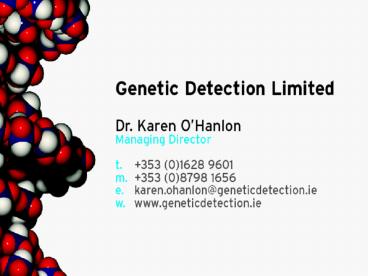Molecular Identification Methods - PowerPoint PPT Presentation
1 / 29
Title:
Molecular Identification Methods
Description:
... Strain Level IDs Sequencing ITS region - Strain level identification RFLP Restriction Fragment Length Polymorphism Identification and differentiation PFGE ... – PowerPoint PPT presentation
Number of Views:529
Avg rating:3.0/5.0
Title: Molecular Identification Methods
1
(No Transcript)
2
Molecular Identification Methods
- Confirmation of identity for commonly used
laboratory strains should ideally be done at the
level of genotypic analysis... Pharmacopeial
Forum, Volume 30 (5) 2004 Microbiological Best
Laboratory Practices, Page 1717)
3
Overview
- Current phenotypic methods/ Problems
- Molecular case studies in industry
- PCR/Sequencing techniques
- Species level ID and Commercial systems
- Strain level ID and Commercial system
4
Phenotypic Methods
- Morphology
- Growth Characteristics
- Serotyping
- Phage typing
- Bacteriocin
- Biochemical Characteristics
- phenol red carbohydrate, catalase production,
oxidase production, tests, methyl red test,
nitrate reduction,starch hydrolysis, tryptophan
hydrolysis, hydrogen sulfide production, citrate
utilization, and litmus milk
5
Microbiological Analyses
Create microbe on plate
Streak on fresh plate
Biolog
Vitek
Gram Stain
6
Problems With Microbiological Testing in QA
Laboratories
- Gram staining, messy, time consuming
- Biolog/Vitek time consuming 2-3 days
- Large amount of isolates unidentifiable
- Only identifiable to genus, species level
- Some non-specific, moulds take 2-3 weeks, many
repeats
7
Microbiological Testing in IndustryHow can
Molecular Methods Improve Testing?
- Sterility testing
- Environmental testing
- Raw material testing
- Water testing
- Personnel monitoring
8
When Genotyping Necessary?
- Sterility Test positive
- Requires
- Investigation, corrective and preventative action
(best case)
9
Pharmaceutical Case Study Investigation 1
10
Pharmaceutical Case Study Investigation 1 PFGE
- The PFGE results showed identical banding
patterns by not1 digest and are the same strain
of Bacillus pumilus
11
Pharmaceutical Case Study Investigation 2
12
Pharmaceutical Case Study Investigation 2 BoxAIR
13
PCR
14
Sequencing Method
15
Automatic Sequencing
16
Species Level ID
Sequencing rRNA Genes
411 completed bacterial genomes
Structural Conserved regions Universal Not
laterally transferred
17
How is Ribosomal DNA Sequencing Carried Out?
- Ribosomal 18S/16S or 28S/23S
18
Commercial Systems Species level ID
- Species Level IDs
- Microseq Applied Biosystems
- Sherlock (DNA) Midi Inc.
- Riboprinter (strain level?) DuPont Qualicon
- Bax (food pathogens, 0157 etc. ) DuPont
Qualicon
19
Microseq and Sherlock-DNA
- 3 Databases
- Fungal D2 region of large rRNA subunit
- Bacterial 16S full sequence (1500bp), 16S
partial sequence (500bp) - Microseq Software and Database adheres to good
manufacturing practice (CGMP) regulations (21 CFR
part 11 for audit trails)
20
Strain Level IDs
- Sequencing ITS region
- - Strain level identification
- RFLP Restriction Fragment Length Polymorphism
- Identification and differentiation
- PFGE Pulse Field Gel Electrophoresis
- Epidemiological studies
- BoxAIR-PCR BoxA Inverse Repeat PCR
- Identification and differentiation
- Commercial System
- Ribotytping
- -RFLP principle
21
Sequencing to Strain Level Identification
- ITS (Internal transcribed spacer regions)
- between 18S and 28S
- Or 16S and 23S
22
RFLP
- RFLP (Restriction Fragment Length Polymorphism)
- Restriction digest of
- direct extracted DNA
- amplified selected genes via PCR
23
Example of a PFGE Analysis on Staphylococcus
aureus.
24
PFGE
Figur
e 2. Example of a real PFGE drug resistant
Staphylococcus aureus. The molecular weight
markers are digested lambda phage (?) and are
given in kb. See the CDC web page with the
original data .
25
BOXAIR-PCR
- BOX-PCR (Amplification of BOX-cassettes)
- Rapid detection method with high reproducibility.
26
Commercial System - Strain level ID
adheres to good manufacturing practice (CGMP)
regulations (21 CFR part 11 for audit trails)
Riboprinter
27
Ribotyping
28
Riboprinter Batch System Report
29
Summary
- Species Level ID
- Sequencing 16S/5S/23S genes (bacteria)
- Sequencing 18S/5.8S/28S (fungal)
- Strain Level ID
- Sequencing ITS region
- PFGE Pulse Field Gel Electrophoresis
- RFLP Restriction Fragment Length Polymorphism
- BoxAIR-PCR BoxA Inverse Repeat PCR
- Ribotytping































